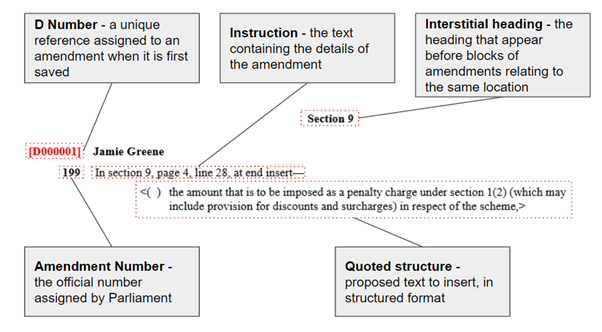Glossary of terms
A list of terms that are used in Lawmaker, the help documentation or in drafting and managing legislation with explanations of what they mean. Includes a guide to amendment terminology.
Abbreviation or term | Description |
|---|---|
AKN Schema | The set of rules that define whether an XML document is structured in accordance with the Akoma Ntoso standard for legislation (referred to as “AKN”). In the Document Checks panel to the right of the Editor, you can select whether to show errors relating to this or not - see Document checks - validating your document |
Toastie | A brief, non-intrusive notification that appears on the screen for a short time when you have completed or are about to perform an action e.g. success messages and warning messages |
Placeholder | A temporary piece of text that takes the place of content that will be added later for example, when inserting a provision into the Editor, it will usually include a ‘Text’ placeholder which you can type into. |
Breadcrumb | Displayed at the bottom of the Editor View (by default but can be moved to the top of the Editor View). The breadcrumb provides context behind your cursor location when in the Editor e.g. if your cursor is within a subsection within a bill, the breadcrumb will let you know the full context of that subsection e.g. Bill > Body > Cross heading > Section > Subsection |
Grouping element | A container for lower-level elements. In Lawmaker, grouping elements are:
and within Schedules there are:
|
Attribute | Part of an XML element (see below) which provides further information about that element but is not text within the XML document. See Introduction to XML |
Closing words | Where a provision is subdivided into paragraphs, any text after the last paragraph. Sometimes referred to as the “full-out text”. |
Content Completion Assistant (CCA) | The element insert menu that pops up when you press Enter in the Editor. See Inserting provisions and other elements. |
Demote | Changing an element into the next logical element further down in the hierarchy, e.g. you can demote a paragraph to a sub-paragraph. See Promoting and demoting provisions. |
Element | The main building block of XML documents. Each provision in a Lawmaker document is represented by an element. An element has a start and end tag and may have attributes and contain text and other elements. See Introduction to XML |
LDAPP | Legislative Drafting, Amending, and Publishing Programme. The project responsible for the initial development of Lawmaker. |
Lawmaker | The name of the application and the service. |
Modal | Another term for “dialog box”. Used in software development and descriptions of the user interface. |
Opening words | Where a provision is sub-divided into paragraphs, the text before the first paragraph. Sometimes referred to as the “lead-in” text. |
Promote | Changing an element into the next logical element higher up in the hierarchy, e.g. you can promote a sub-paragraph to a paragraph. See Promoting and demoting provisions. |
Quoted structure | The element used to contain a textual amendment in a Bill or Act, or to contain provisions being inserted as part of a parliamentary amendment. See Quoted structures. |
Significant version | A read-only version of a document that has been created by Lawmaker as a result of a document being published, marked as signed, submitted to TNA or shared with another organisation. See Documents and folders on the Project Tab. |
Snapshot version | A read-only snapshot of a working version that has been created by the user or automatically by Lawmaker. See Documents and folders on the Project Tab. |
Structure View | The outline view of the document in the left-hand panel. See Using the structure view. |
Unwrap | Removing a grouping level element e.g. Part or Chapter which will remove the start and end tags that are ‘wrapping’ the child provisions within them e.g. sections. See Wrapping and unwrapping provisions. |
Working version | An unpublished version of a document that you can view and edit. See Documents and folders on the Project Tab. |
Wrap | The term given when inserting a grouping element e.g. Part or Chapter. In XML terms, the child provisions are encapsulated within the start and end tags of the grouping element which is where the notion of ‘wrap’ comes from. See Wrapping and unwrapping provisions. |
XML | eXtensible Markup Language. See Introduction to XML . |
X-ref | A Cross reference to another provision. See References. |
MFA | Multi-Factor Authentication. See Multi-factor authentication guide |
Amendment terminology
Here is a guide to the language used to describe the different parts of a parliamentary amendment:

